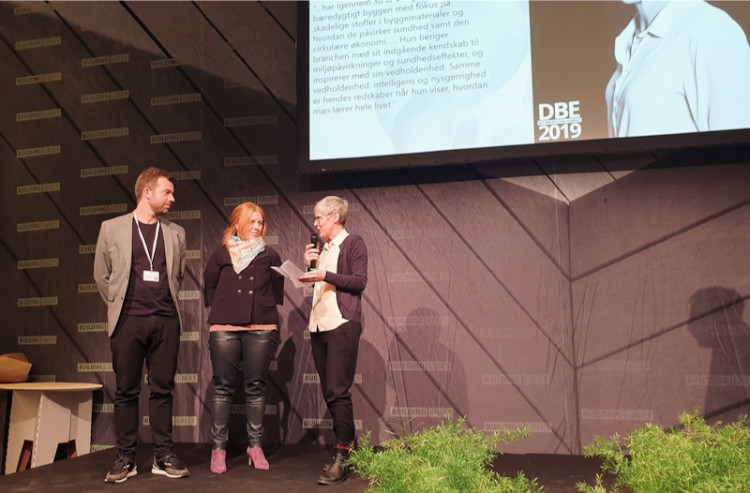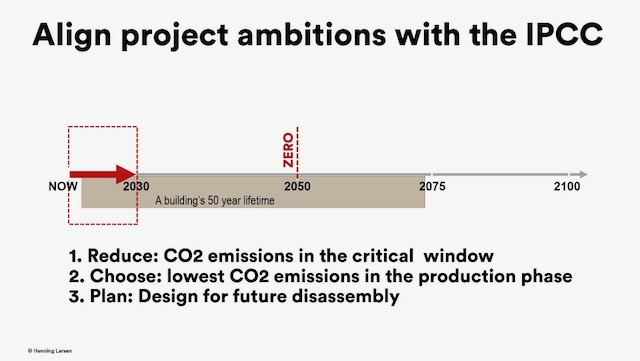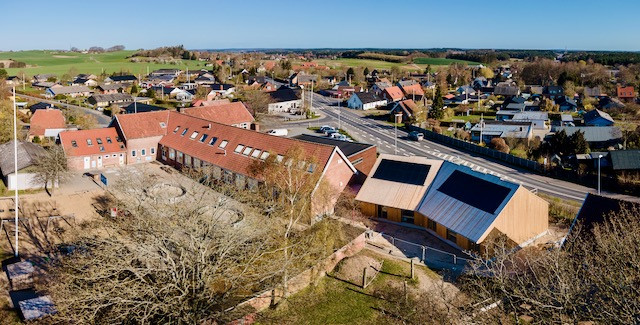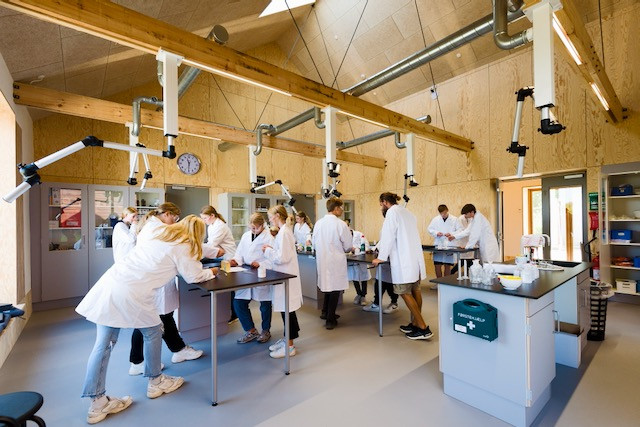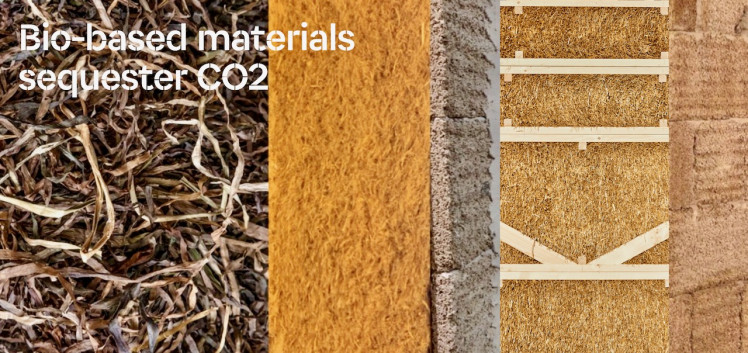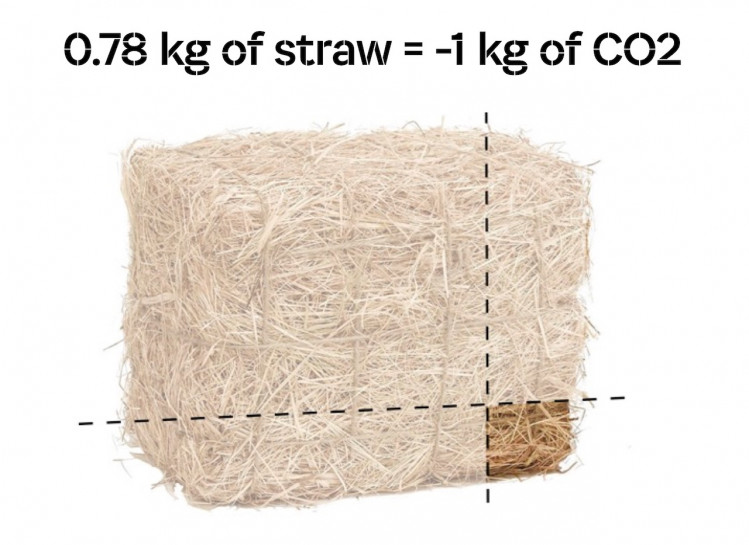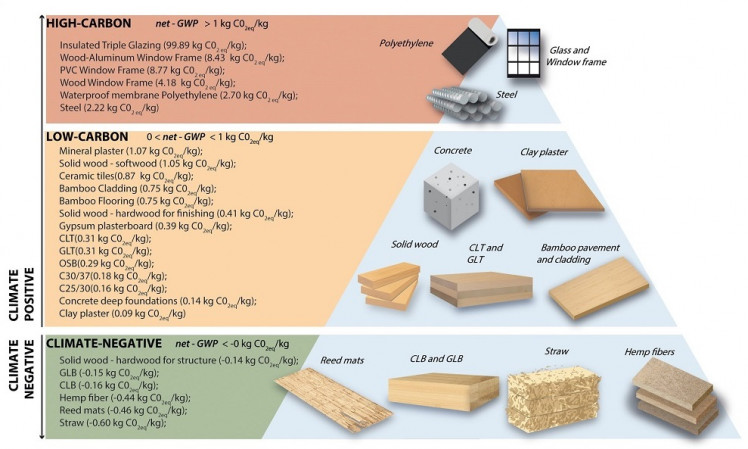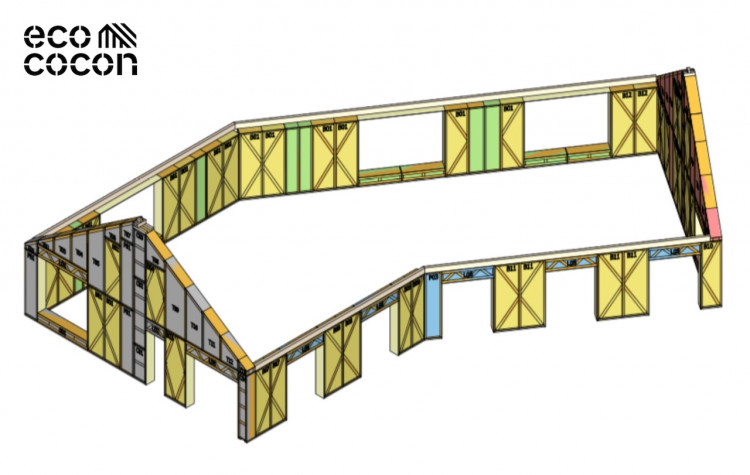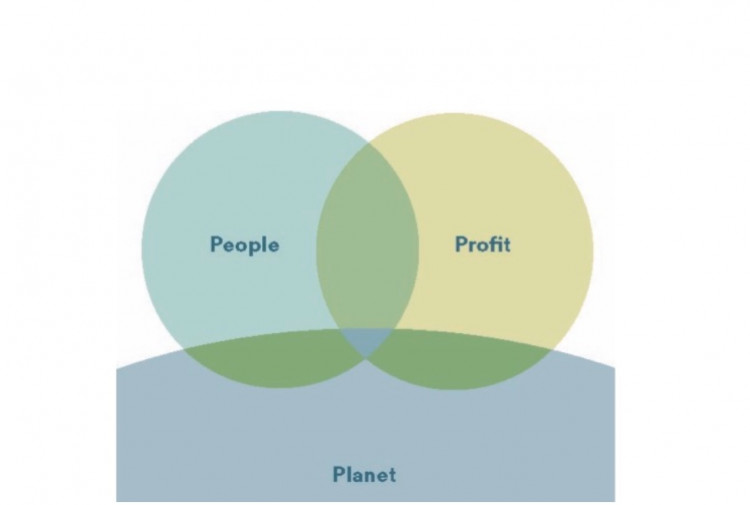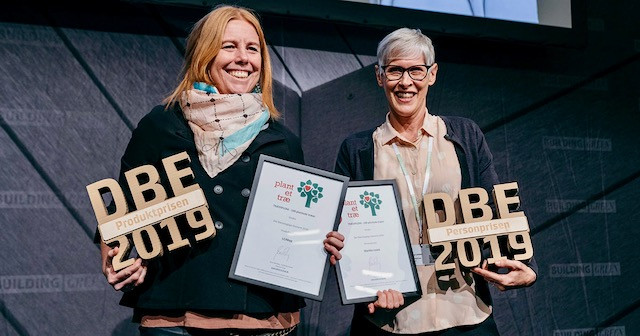In our second interview with Martha Lewis, senior architect and head of materials at Henning Larsen, we looked at the challenges choices of materials have upon the world of architecture.
How can we make a difference in the decisions we make, starting from the very drawing board?
What is Henning Larsen doing differently and what can we learn from their approach? And why do we need a material pass - an inventory of what is really in building products?
With a desperate need to tackle climate change, Martha reveals the significance of the Feldballe Free School project using the EcoCocon system in Denmark, a step in the right direction.
Discover:
- Why using conventional building materials is overstepping planetary boundaries
- How to align your project with the IPCC goals
- Why concrete should cost more than it does today
- The true potential of material pass and digitalisation in the building industry
- What it takes to introduce circularity standards for building materials
- How to redraw the diagram defining sustainability
If you missed the first interview, you can catch up on what you missed here.
A large part of your work at Hennign Larsen is resource-conscious design - making sure that sustainability is a core component of the construction process from the very beginning. What are the sustainability challenges that the building industry is facing today?
There are so many issues right now, it’s overwhelming, particularly for the building industry.
We have a resource scarcity issue looming on the horizon, and a biodiversity, pollution and climate change crises that have already arrived.
The major challenges of the century are whirling around building products because these are our resources: this is what we need to build the huge amount of housing necessary to handle the urban population explosion. And unfortunately, many construction products have high environmental impacts, contributing to global warming potential and increased pollution. Scientific data indicate that 5 of the 9 planetary boundaries defining the safe operating space for the planet have been breached.
And it seems like we are running out of time to address all these issues…
Given the last year’s IPCC report, the message is clear. We have less than a decade - 2030 closes our operating window. Projects on the drawing board have to make the best possible decisions. If you don’t know where your structural materials are in terms of carbon emissions per cubic metre, you’d better find out.
Planners should make decisions based on the environmental impacts in the production phase, and choose materials and products with the lowest embodied carbon. This is also known as the upfront carbon.
For example, bio-based materials, like timber, straw, hemp sequester carbon in the production stages. They take carbon dioxide out of the atmosphere thanks to photosynthesis in the growth phase and store it in the form of carbon in the building.
If you work with life cycle assessment, theoretically defined as 50 years, sometimes 60, you should be aware that though the numbers show a benefit in the production phases, the end results for those bio-based materials in the calculations take you back to zero. The material is sequestering CO2 in growth and production phases, yet the default scenario for end of life of the material is incineration.
I’m quite certain that in 50 years, we will NOT be burning the buildings constructed today and allowing free release of CO2 into the atmosphere. This default scenario does not reflect possible future resource treatments, but rather is based on projecting today’s waste treatment into the future.
We need to make good decisions about carbon sequestration and design buildings with the possibility to retrieve those bio-based materials in the future, disassemble and reuse them in other projects.
The design for disassembly is something you used in the Feldballe Free School project, where Henning Larsen partnered with EcoCocon. How did the idea of this joint project arise?
This was one of these fabulous synergies, where the right people are connected and the collaboration is extraordinarily fruitful.
Some of our forward-thinking architects met Lars Keller from EcoCocon Denmark at the Building Green 2019 event and had a really good dialogue with him. EcoCocon had recently sent shipments of straw wall elements to a school in Møn in Denmark, and that sparked an interest for Henning Larsen.
Lars mentioned a school building needing architects in Feldballe, and Henning Larsen saw an opportunity to work with the straw panels and develop a strong architectural expression. A small carbon footprint and design for disassembly were two of the guiding design principles. In fact, Henning Larsen summarized the project ambitions with five dogmas. The dogmas are a framework for designing with planetary health in mind.
What challenges did the school project present?
At the beginning, we were looking into the carbon footprint in the production phase of previous projects, to see which of the building components needed to be improved. The lead design architect, Magnus Reffs Kramhøft, and the construction architect, Peter Tegner Matz, explored alternative constructions. How can we minimise the use of concrete and sequester more carbon in the building?
The focus was on the foundations - how to improve on the standard Danish solution of using concrete in the slab and perimeter foundations. Peter detailed a solution with steel screw foundations and a timber slab, a solution which would have saved 1 kg CO2e/m2/year calculated over a lifetime. However, due to the project's economy, the project moved forward with the concrete version.
Concrete is really cheap, that's the challenge. We need to have a policy shift, for example an effective carbon tax where the polluter pays in order to change that. The concrete industry is contributing to the existential threat that the globe is facing. Aalborg Portland should be paying a tax on cement that answers the degree of hazard of that impact. The cost of concrete should include the fact that they are threatening the future existence of civilisation.
It seems apt that a school building which is a science project is built with sustainable materials and with an architecture firm with a progressive approach to technology.
Anyone who has kids and works in the building industry simply has to do everything they can to encourage carbon-storing, bio-based materials, and commit to lobbying the government to come up with a fair and adequate reaction - a tax that reflects the pollution actually happening.
What other choices besides using bio-based materials, do we have to improve the situation?
As architects we need to be extraordinarily conscious about every single project. Should we build this at all? Can we build it without a basement to minimise the use of concrete? Can the existing building structure be preserved?
One guideline is to remember the many “R”s - Refuse, Reduce, Reuse, Regenerate, Repurpose, Reassess, Recycle and I like to tag on Re-wild. It’s a radical solution, but what if we refused to build new, and focused instead on renovation and transformation? This allows for huge carbon savings as well as saving resources.
Reassess the insulation you are using by investigating the global warming potential of various insulations. A new building facade has a heavy carbon impact. Look at what you’re building the facade out of, as well as the ratio between glass openings and solid openings. Daylight is tremendously important but so is heat gain, so we need a smart balance.
There are other issues that are really difficult. For example, how can we as architects make good choices for biodiversity? We can prioritize an informed approach to biodiversity in the landscape project, but what about the built environment?
We can choose FSC or PEFC-certified wood products. Both systems include requirements for securing biodiversity. However, this is the only way I know of today where biodiversity is being reviewed in a product’s life phase; we’re simply missing information about this. There’s no way to determine if a product is good or bad in terms of its impact on biodiversity. Ideally new metrics indicating biodiversity should be integrated into product lifecycle impact data.
You said, the “best results come from a collaboration between architects and engineers in the early design phases…”
Maybe we should add manufacturers as well! If we look at our last project with Feldballe, I would say you have to work with people who are really driven and passionate. You have to make strategic alliances to work with people who are change makers, and they may have unusual hats, ones that you didn’t necessarily think of.
What should the architects change in their approach during the creative phase of the project?
We need to re-assess our palette of materials. It’s comfortable to lean back and say: “I’ve planned bathrooms for 30 years, you have to follow this regulation, you have to do use these materials.”
But it’s often in the bathroom where you find all the products with hazardous content. We need to challenge the system, and maybe the best way is on smaller pilot projects, such as Feldballe.
How can we challenge the old ways?
We have to reevaluate the conventional building materials. See if you can challenge chemical and plastic use and reduce highly carbon emitting products. Reduce the plastic, reduce concrete, steel, and aluminium.
Aluminium is an interesting case. As everyone knows, it has the potential to be highly recyclable. However, the carbon emissions from aluminium products with recycled aluminium are also very high. Just because a product is recycled, it doesn’t mean it has a small carbon footprint.
The potential of future recycling does literally nothing for the current urgent climate crisis. The comment I have heard many times: “It’s sustainable because it’s recyclable”. Yes, there is a high probability that it will be recycled at the end of life, but that’s too late. We have to look at the next 10 years and understand the urgency of the climate crisis.
You have to figure out how, perhaps inspired by historical and vernacular building technologies, you can work with low carbon products that sequester carbon in the growth phase.
You are involved with developing a circularity standard at an EU level. How is this work progressing?
It is going at a snail’s pace. And that is a crime against humanity. With all respect for administrative procedures at the EU level and thoroughness needed to establish new standards, this is essential work that should be accelerated to address how we are using resources in light of the various planetary crises.
A whole set of standards is missing to encourage direct reuse of building components, so that security can be given to engineers and clients who choose to prioritize climate change impact reductions and prudent resource use.
It would be fantastic if we had circularity standards for steel and concrete, so we could take structural elements out of existing buildings that are being dismantled. We need to find a way to get the steel out of those buildings and not melt it down again, but rather try to send it into a reuse cycle.
What needs to be tested in order to certify it for its second life? How can we run this through a review procedure, improve weaknesses, or determine where the reuse is not justifiable?
We need a standard to define the review and approval procedure for a steel beam to come from one building into the next, and the same thing for concrete.
What are the top technologies that you see as most promising in pushing the construction industry towards a more sustainable one?
I research materials, and I see where digitalisation can help material flows. It is necessary that we begin to look at our buildings as building banks, and consider them a collection of resources for the future generations.
Not only do we have to be clear about the carbon content we put into that bank, it’s also important to design for the future with details that allow for disassembly and reuse to ensure the carbon goes into the next building. In order to make reuse in the built environment operational, we need to have well established digital processes to document and to track contents of products and buildings.
That is simply added value for clients: if the data is available regarding amounts, product content, accessibility and potential lifetime, the building’s estimated value can be calculated. In the future, a digital assessment could provide the client with useful economic information, such as the residual value of the resources in the building on any given day.
Could you give an example of how this can work?
Let’s say you have copper wall cladding inside your building, as a client, you can follow copper prices linked into the project specific quantity data. The CLT screwed together in the building could have a second life, because it is well-protected from the elements, and with documented quantities, information regarding the adhesive content in the CLT as well as adhesive used between structural elements, and perhaps data from humidity sensors, you can calculate the effort needed to reclaim this structural element, as well as the current market value.
All these pieces of information play a role in assessing whether a building component actually has a value in its next life, and that’s a value which will fluctuate over time. But to be able to access the ‘where am I today’ - digital product documentation and tools are a necessity.
Information on availability, accessibility, quality and quantity is what’s needed to engender a successful flow of materials. Digitalisation plays a big role by supporting the logistics of a functioning circular exchange..
We also need to determine which information we are making publicly accessible and when. A private owner has private information - the world doesn’t need to know about the copper wall cladding - but when at the moment of sale, it’s essential to be able to tap into a digital flow system for material exchange. There is a huge potential for future resource use and for economic gain.
What about traceability and transparency in building documentation? Can this also be tackled with digitalisation?
We need a material pass on building products. For a material pass to do its job, it needs to be digital. To make this a reality, I’m working with a cross-industry initiative in Denmark with NCC, one of the biggest contractors in the Nordic countries, and with SundaHus from Sweden, experts in material data collection and assessment.
It requires content and reuse potential information. In the planning phase, architects and consultants can choose materials that have a proactive reuse potential - that won’t end up as landfill or burned. They can be removed from one construction, have a future life, and can come into another flow or perhaps be re-used directly.
How would this data be presented?
There is good potential in working with an open data format linked into our BIM or IFC models in the planning phase. In the construction phase, the contractor can add necessary information, such as which product was actually installed, and whether for example the ceiling panels were screwed in, glued, hung, or mounted in other ways.
This establishes a strong foundation to ensure future circular reuse, especially when the data is digitalised and linked to the physical product in the building, for example as a QR code. Ideally the data should be personalized over time, so you have the history of what’s happened to the steel beam in the steel beam itself. History is important - I was a history major in college!
In spite of all the efforts and initiatives, the construction sector remains one of the biggest polluters. What more should we do?
For many decades, the sustainable sector in the construction industry has worked with the triple bottom line: trying to achieve a fine balance between the profits, people and planet. Several certification systems are based on this Venn diagram: that we need to address environmental, ecological and social concerns, and as long as there’s a good balance and some ambition is reached in each category, the project is declared sustainable.
But, guess what? This hasn’t panned out. Our sustainably certified buildings may be meeting the needs of the present, however they are without doubt compromising the ability of future generations to meet their own needs. There is new data demonstrating that of the 9 planetary boundaries, we have overstepped 5 of them and are currently operating outside of the space defined as safe for the planet and for humanity.
Many certified buildings are essentially build-as-usual when it comes to global warming potential. Our conventional building products such as concrete, steel, aluminium, bricks, glass and mineral-based insulation leave a large carbon footprint. Unless there are immediate and drastic changes to build-as-usual, we are looking at a 5 degree warming by the end of the century. Unless you have the environment, that is, planetary health, as your fundamental basis, as a number one priority; unless that is the ground upon which we stand in making our decisions, then the economy is irrelevant and populations are endangered.
We need to redraw that diagram that everyone fell in love with and heralded as the path to a sustainable built environment. It’s not sustainable. We have to rethink that triple bottom line. The planet, ecosystems and biodiversity are the most important and should be the basis for all the decisions in the building industry, not how much revenue companies are able to generate.
MARTHA LEWIS
Martha Lewis is head of materials and senior architect at Henning Larsen. She is a winner of the 2019 DBE Person Prize by Building Green, an annual prize for outstanding commitment to sustainability. Martha has worked for 30 years establishing sustainability-focused partnerships and initiatives in the building industry in Denmark. She describes herself as an architect “knowledgeably hyping healthier materials”.

